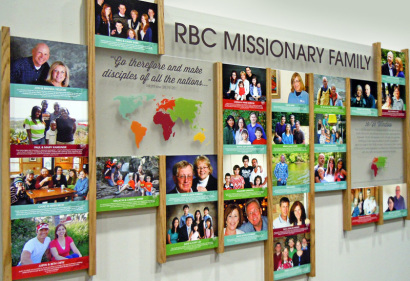One of the many specialized graphic design services that we specialize in is environmental graphics. This term often raises the question, “what is environmental graphic design?” The name alone tends to lead people to thinking it involves dealing with nature or going green, but it’s far from those connotations.
Environmental graphic design uses visual aspects to embrace interior spaces and uses multiple design disciplines to transform them into unique environments that communicate the shape and story of a place. Simply put, environmental graphic design creates environments for visitors. The best example is to think of a museum exhibit.
Museum/Corporate Exhibits
 Typically when you walk into a museum exhibit, everything from the lighting, flooring, wall murals, and graphic panels are designed to give off a specific emotion. This intended emotion helps to develop a stronger message that the exhibit is trying to convey, another term for this is information design. Imagine walking into an exhibit at a very prestigious museum and the exhibit contains stark white walls, bright lighting, concrete flooring, and very boring graphic panels. If this is an exhibit about racism in the south during the civil war, this exhibit will not leave a strong impact on the visitor and is very different from the message it is portraying. However if you were to enter the same exhibit but the room has darker walls with bold mural graphics, subdued color tones with maybe a few bold colors, and spot lighting on the graphic panels, the message is going to be better received and a lasting impact will be made. Environmental graphic design also is incorporated into traveling museum exhibits and trade show exhibits.
Typically when you walk into a museum exhibit, everything from the lighting, flooring, wall murals, and graphic panels are designed to give off a specific emotion. This intended emotion helps to develop a stronger message that the exhibit is trying to convey, another term for this is information design. Imagine walking into an exhibit at a very prestigious museum and the exhibit contains stark white walls, bright lighting, concrete flooring, and very boring graphic panels. If this is an exhibit about racism in the south during the civil war, this exhibit will not leave a strong impact on the visitor and is very different from the message it is portraying. However if you were to enter the same exhibit but the room has darker walls with bold mural graphics, subdued color tones with maybe a few bold colors, and spot lighting on the graphic panels, the message is going to be better received and a lasting impact will be made. Environmental graphic design also is incorporated into traveling museum exhibits and trade show exhibits.
Wayfinding & Signage
Another example of environmental graphic design is the use of wayfinding and signage. Let’s first define what wayfinding is as its more of an industry term. Wayfinding typically involves the use of signage, landmarks, and pathways in a physical space and helps people navigate from one place to another. By using visual information it helps you know where you are in a building or even a city, and often times provides directions on how to get to other desired locations. One easy way to get a picture of a wayfinding is to simply think of walking into a hospital. How do you know where the ER room is or the prenatal unit? Typically there is a set of directional arrows on signs that guide you to your intended location. We’ve all seen the city maps that show landmarks and provide a birds eye view of the roads to help you navigate around a city, this is another example of wayfinding. Signage is another medium that helps to transform a space as it may include large banners, murals, three-dimensional letters and so forth.
Retail Space & Corporate Interiors
One of my favorite stores to window shop in is Anthropologie. I love first walking along the storefront to see beautiful window displays, then walking in the doors and hearing the relaxing and upbeat music, seeing the soft and bold colors, variety of textures and decor and so forth. You can picture it can’t you? On the other hand, I also love walking into Niketown in Chicago and seeing huge banners of athletes in motion, industrial clothing rack displays and observing how they bring the games indoors. Truth is, these stores are planned and designed to create an environment for the consumer. These such environments are also created inside corporations as well. Many corporations will carry their branding throughout their corporate headquarters and even into a corporate museum to further create a since of space for the visitor.
Furthermore, environmental graphic design is the shaping of a space through different design disciplines and can consist of museum exhibits, wayfinding and signage, retail spaces and corporate interiors. Other examples that help build spaces are history walls, donor walls, and interpretive panels.
R2F Creative LLC provides graphic design + branding and web design solutions for clients nationwide and locally in Ankeny and Des Moines, Iowa.
